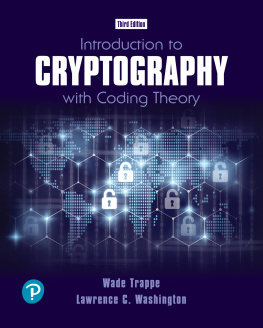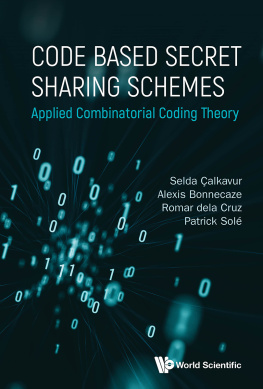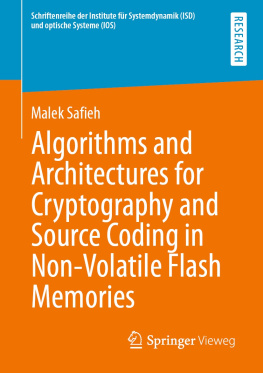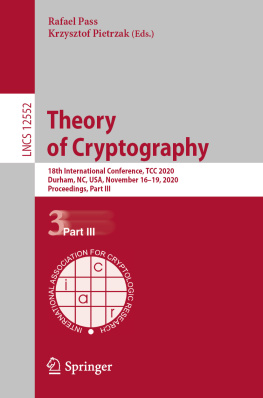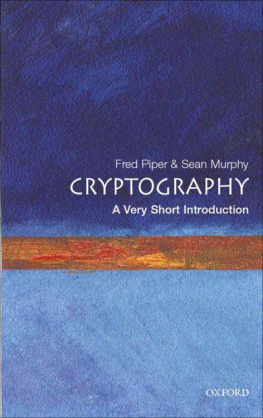Wade Trappe - Introduction to Cryptography: With Coding Theory
Here you can read online Wade Trappe - Introduction to Cryptography: With Coding Theory full text of the book (entire story) in english for free. Download pdf and epub, get meaning, cover and reviews about this ebook. year: 2020, publisher: Pearson Education, genre: Children. Description of the work, (preface) as well as reviews are available. Best literature library LitArk.com created for fans of good reading and offers a wide selection of genres:
Romance novel
Science fiction
Adventure
Detective
Science
History
Home and family
Prose
Art
Politics
Computer
Non-fiction
Religion
Business
Children
Humor
Choose a favorite category and find really read worthwhile books. Enjoy immersion in the world of imagination, feel the emotions of the characters or learn something new for yourself, make an fascinating discovery.
- Book:Introduction to Cryptography: With Coding Theory
- Author:
- Publisher:Pearson Education
- Genre:
- Year:2020
- Rating:4 / 5
- Favourites:Add to favourites
- Your mark:
- 80
- 1
- 2
- 3
- 4
- 5
Introduction to Cryptography: With Coding Theory: summary, description and annotation
We offer to read an annotation, description, summary or preface (depends on what the author of the book "Introduction to Cryptography: With Coding Theory" wrote himself). If you haven't found the necessary information about the book — write in the comments, we will try to find it.
Introduction to Cryptography: With Coding Theory — read online for free the complete book (whole text) full work
Below is the text of the book, divided by pages. System saving the place of the last page read, allows you to conveniently read the book "Introduction to Cryptography: With Coding Theory" online for free, without having to search again every time where you left off. Put a bookmark, and you can go to the page where you finished reading at any time.
Font size:
Interval:
Bookmark:

with Coding Theory
3rd edition
Wade Trappe
Wireless Information Network Laboratory and the Electrical and Computer Engineering Department Rutgers University
Lawrence C. Washington
Department of Mathematics University of Maryland
Portfolio Manager:Chelsea Kharakozoua
Content Manager:Jeff Weidenaar
Content Associate:Jonathan Krebs
Content Producer:Tara Corpuz
Managing Producer:Scott Disanno
Producer:Jean Choe
Manager, Courseware QA:Mary Durnwald
Product Marketing Manager:Stacey Sveum
Product and Solution Specialist:Rosemary Morten
Senior Author Support/Technology Specialist:Joe Vetere
Manager, Rights and Permissions:Gina Cheselka
Text and Cover Design, Production Coordination, Composition, and Illustrations:Integra Software Services Pvt. Ltd
Manufacturing Buyer:Carol Melville, LSC Communications
Cover Image:Photographer is my life/Getty Images
Copyright 2020, 2006, 2002 by Pearson Education, Inc. 221 River Street, Hoboken, NJ 07030. All Rights Reserved. Printed in the United States of America. This publication is protected by copyright, and permission should be obtained from the publisher prior to any prohibited reproduction, storage in a retrieval system, or transmission in any form or by any means, electronic, mechanical, photocopying, recording, or otherwise. For information regarding permissions, request forms and the appropriate contacts within the Pearson Education Global Rights & Permissions department, please visit www.pearsoned.com/permissions/.
Text Credit: Page Declaration of Independence: A Transcription, The U.S. National Archives and Records Administration.
PEARSON, ALWAYS LEARNING, and MYLAB are exclusive trademarks owned by Pearson Education, Inc. or its affiliates in the U.S. and/or other countries.
Unless otherwise indicated herein, any third-party trademarks that may appear in this work are the property of their respective owners and any references to third-party trademarks, logos or other trade dress are for demonstrative or descriptive purposes only. Such references are not intended to imply any sponsorship, endorsement, authorization, or promotion of Pearsons products by the owners of such marks, or any relationship between the owner and Pearson Education, Inc. or its affiliates, authors, licensees or distributors.
Library of Congress Cataloging-in-Publication Data
Names: Trappe, Wade, author. | Washington, Lawrence C., author.
Title: Introduction to cryptography : with coding theory / Wade Trappe, Lawrence Washington.
Description: 3rd edition. | [Hoboken, New Jersey] : [Pearson Education], [2020] | Includes bibliographical references and index. | Summary: This book is based on a course in cryptography at the upper-level undergraduate and beginning graduate level that has been given at the University of Maryland since 1997, and a course that has been taught at Rutgers University since 2003" Provided by publisher.
Identifiers: LCCN 2019029691 | ISBN 9780134860992 (paperback)
Subjects: LCSH: Coding theory. | Cryptography.
Classification: LCC QA268.T73 2020 | DDC 005.8/24dc23
LC record available at https://lccn.loc.gov/2019029691
ScoutAutomatedPrintCode
ISBN-13: 978-0-13-485906-4
ISBN-10: 0-13-485906-5

This book is based on a course in cryptography at the upper-level undergraduate and beginning graduate level that has been given at the University of Maryland since 1997, and a course that has been taught at Rutgers University since 2003. When designing the courses, we decided on the following requirements:
The courses should be up-to-date and cover a broad selection of topics from a mathematical point of view.
The material should be accessible to mathematically mature students having little background in number theory and computer programming.
There should be examples involving numbers large enough to demonstrate how the algorithms really work.
We wanted to avoid concentrating solely on RSA and discrete logarithms, which would have made the courses mostly about number theory. We also did not want to focus on protocols and how to hack into friends computers. That would have made the courses less mathematical than desired.
There are numerous topics in cryptology that can be discussed in an introductory course. We have tried to include many of them. The chapters represent, for the most part, topics that were covered during the different semesters we taught the course. There is certainly more material here than could be treated in most one-semester courses. The first thirteen chapters represent the core of the material. The choice of which of the remaining chapters are used depends on the level of the students and the objectives of the lecturer.
The chapters are numbered, thus giving them an ordering. However, except for for ease of reference; however, we recommend introducing these concepts gradually throughout the course as they are needed.
The chapters on information theory, elliptic curves, quantum cryptography, lattice methods, and error correcting codes are somewhat more mathematical than the others. The chapter on error correcting codes was included, at the suggestion of several reviewers, because courses that include introductions to both cryptology and coding theory are fairly common.
Suppose you want to give an example for RSA. You could choose two one-digit primes and pretend to be working with fifty-digit primes, or you could use your favorite software package to do an actual example with large primes. Or perhaps you are working with shift ciphers and are trying to decrypt a message by trying all 26 shifts of the ciphertext. This should also be done on a computer.
Additionally, at the end of the book are appendices containing computer examples written in each of Mathematica, Maple, MATLAB, and Sage that show how to do such calculations. These languages were chosen because they are user friendly and do not require prior programming experience. Although the course has been taught successfully without computers, these examples are an integral part of the book and should be studied, if at all possible. Not only do they contain numerical examples of how to do certain computations but also they demonstrate important ideas and issues that arise. They were placed at the end of the book because of the logistic and aesthetic problems of including extensive computer examples in these languages at the ends of chapters.
Additionally, programs available in Mathematica, Maple, and MATLAB can be downloaded from the Web site (bit.ly/2JbcS6p). Homework problems (the computer problems in various chapters) based on the software allow students to play with examples individually. Of course, students having more programming background could write their own programs instead. In a classroom, all that is needed is a computer (with one of the languages installed) and a projector in order to produce meaningful examples as the lecture is being given.
Font size:
Interval:
Bookmark:
Similar books «Introduction to Cryptography: With Coding Theory»
Look at similar books to Introduction to Cryptography: With Coding Theory. We have selected literature similar in name and meaning in the hope of providing readers with more options to find new, interesting, not yet read works.
Discussion, reviews of the book Introduction to Cryptography: With Coding Theory and just readers' own opinions. Leave your comments, write what you think about the work, its meaning or the main characters. Specify what exactly you liked and what you didn't like, and why you think so.

